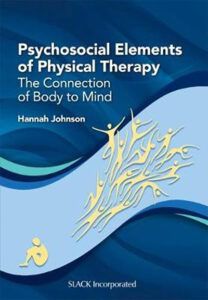Welcome back to the Healing Pain Podcast with Hannah Johnson, PT, DPT, GCS
My guest is Hannah Johnson. She is a clinician as well as an educator. She earned DPT in 2013, as well as a Geriatric Clinical Specialist certification in 2016. In 2018, she published her book, Psychosocial Elements of Physical Therapy in effort to fill the gap in mental health education for physical therapists and physical therapy students. Her PhD research explores how to improve interdisciplinary quality care in nursing homes.
In this episode, you’ll learn about the biggest obstacles in physical therapists management of complex patients. You’ll learn how residents of long-term care facilities can keep up their physical activity, as well as evidence-based supported practical strategies for managing behavior such as agitation, aggression, refusal of care and inappropriateness that are often associated with various medical, psychological and social conditions. I highly recommend you check out Hannah’s book. It’s an excellent resource for physical therapists and other health professionals. Without further ado, let’s begin and let’s meet Hannah.
—
Watch the episode here:
Subscribe: iTunes | Android | RSS
Managing Complex Patients: Long-Term Care Behavior And Activity Management Strategies With Hannah Johnson, PT, DPT, GCS
Hannah, thanks for joining me.
It’s good to be here.
I came across the book of yours called Psychosocial Elements of Physical Therapy. It’s full of great information with regards to psychosocial care and how it relates to physical therapy. I know you’re doing some great work both in your clinical practice as well as in research. A good place for us to start is to discuss what your line of research is and how that’s pulling or drawing you in one direction.
To explain a little bit more about my clinical background, I’ve worked in long-term care since I graduated with my Doctorate in Physical Therapy a number of years ago. The population with mental health, psychiatric issues, and behavior issues always attracted me. A couple of years of clinical practice prompted me to research the book and write it more to inform myself and other clinicians who may not necessarily have a lot of training in mental health disorders and behavior management. From there, I started my PhD at Northern Illinois University. My line of research with that is centered in skilled nursing facilities and focuses more on quality improvement, nursing documentation, and interdisciplinary care. The PhD program itself spans a number of disciplines. My focus is on how the quality improvement of nursing documentation can impact the physical activity for residents with mental illness and those without, and that I hope to continue past the dissertation.
You’re looking at how nursing documentation can impact the physical outcomes that we see in our patients. You’re specifically looking at the context of long-term care in nursing homes. Tell us how nursing documentation, something we don’t necessarily think about as a physical therapist, can have an impact on physical therapy outcomes. What have you discovered so far?
One key component of physical activity in nursing homes comes when patients are not on a therapy caseload at all. For a long-term residency, you will have what’s called a Functional Maintenance Program or Restorative Nursing Program. Both of those are simple physical activity, activity at daily living, and programs that are daily implemented by the nursing staff. The documentation of those programs affects not only the reimbursement for the facility as a whole but also the resident’s quality of life. When we screen those residents in therapy every quarter or as needed, then we can tell with accurate documentation whether or not there has been a true decline. We can determine whether or not to pick them up for therapy.
That’s one obstacle for patient outcomes in long-term care or a nursing facility. What are the biggest obstacles in the management of the complex patients that we see as far as physical therapy goes?
The main one that prompted me to write the book in the first place was the lack of training that a lot of physical therapists and PT assistants have in specific behavior management of people with specific severe mental illness such as schizophrenia. Let’s say you’re going to have to have unique behavioral management strategies with various types of dementia, depression and anxiety. I was trying to synthesize the research and find out number one, how can we manage the behaviors? Number two, what are the specific modes of physical activity that we can promote to these patients so that it will impact not only their physical but also their mental health?
They seem like two different topics. You’re talking about behavior and then physical activity. We know within the biopsychosocial model that those two are intimately related. It is interesting as a physical therapist, there are things like a geriatric certified specialist who might come across more topics like this, but in our entry-level of graduate training, we don’t go to depth into that area.
I would say that’s true. We had more just the pathophysiology of the disease, but then as far as specific behavior management, that was all learned in the clinic as well as by review of the literature.
Let’s talk about physical activity and physical health first. How can a resident of a skilled nursing facility or a long-term care facility keep up their physical ability over the course of their care and their life there?
The amount of support that they will need for keeping up that physical activity depends on partly their cognitive status, as well as the family or social support that they have. For residency with pretty good intact cognition who’s with it but isn’t necessarily physically fit, the physical therapist or occupational therapist could prescribe an exercise program for them to do every day. They could recommend that they participate in activities department programming. For example, chair exercises and things of that nature. For a resident with more impaired cognition, then they would need more support from the nursing staff, as well as potentially more frequent therapy episodes. That can range all the way down to passive range of motion during cares for residents with advanced dementia. That is more to protect the joint and skin integrity so they can be positioned safely.

The frequency is one big issue that you’ve already mentioned, how often someone is being seen by or attending physical therapy and going to the physical therapy gym within the facility. When someone is admitted to a long-term care facility, what’s the typical frequency duration that they’re receiving? Is that diagnosis-specific for them?
It’s a combination of diagnosis and the level of carryover that we anticipate them to have. For residents with worst cognition, we will usually see them at a higher frequency of 5 to 7 times per week because we know that they will not be carrying over the programs themselves. For a resident with more intact cognition who’s going to be a long-term residence, then we will see them maybe 2 to 3 times per week. If we know there’s going to be better carryover by the residents or by staff, we’ll see them less often in therapy.
Are those patients ultimately moving toward a discharged status or are they stepping them down at that point in some way? Is that care continue after that step-down or we hope that care continues?
I would say yes. It does depend on whether the resident has a discharge plan. We can discharge them eventually at the most restrictive level. For example, they can stay in a dementia care unit or a memory care unit. That could be lifelong, all the way back to a group home assisted living, independent apartment with family support, caregiver support, and anything in between. I’ve seen residents stay anywhere from several days to the rest of their lifetime.
Let’s shift gears a little bit and let’s talk about the behavioral approaches that you mentioned. I know you talk a lot about this in your book and people should check out your book. It’s called Psychosocial Elements of Physical Therapy. You can download that and check it out. It’s written exclusively by Hannah. I’ve written a book myself and I looked at Hannah’s book. It’s a great feat of professionalism to look at the psychosocial elements on lots of different levels with regard to physical therapy. Let’s talk about some of those behaviors. People who have Alzheimer’s or dementia at times can be agitated. They can act aggressively toward other residents or other professionals. They can refuse being treated. Things like that oftentimes happen in the facility. How can we look at some strategies to help overcome those barriers?
I’ll start with more evidence-based strategies that I found in the literature for agitation, especially in aggressiveness. It is very important to learn to read those early signs that a person might be on the edge or about to go into a more behavioral episode. We might notice, are they fidgeting more? Do they seem to need to use the toilet? Do they just need to move? Are they hungry or thirsty? Often, it’s those bodily needs or the social interaction needs that are not being met necessarily because in long-term care, there is a lot of isolation. There’s not a lot of interaction and dialogue, especially in our case when the facility is essentially in lockdown and all the residents are staying in their rooms all day. Learning to read those early signs and provide the socialization or the basic personal care needs, it depends on the person, but the personality of the patient and the personality of the therapist.
Sometimes we may need to do a little bit of adjustment. How I usually try to come across to a person with dementia is initially, I try to be very calm and self-aware because they pick up on our emotions rapidly. That’s pretty characteristic across all kinds of mental illness. Getting myself in the proper mood, calming myself and then being able to perhaps redirect the person to an enjoyable activity or re-orient the individual if they’re confused. If they think it’s midnight and they’re 39 years old, they wouldn’t work with you in therapy because you’re waking them up at midnight. Open the window, offer them some water, re-orient them the time and things like that.
Those are good and simple techniques there that rarely are probably taught in school. Sometimes people pick it up on the job training though, when they work with professionals, whether they’re physical therapists or other health professionals that have more experience to them. No one has packaged this together for professionals to rely on and learn from.
That was one of my main goals with the book in order to have a go-to resource for the clinician, as well as for the student.
What are the tips and strategies that you have with regard to the behavioral management of elders in care?
There are several things. First of all, validation of their experiences. I always try to recognize that they’re human beings or human individuals with a past. Sometimes that past may not be clear to them but I try to dig a little bit and become involved in their lives a little bit. The relationship aspect of long-term care between clinicians and patients is very real. We develop solid friendships with these individuals. As far as other behavioral management strategies, we also try to provide a little bit of structure in the session. That’s another thing, but not coming off as bossy and heavy-handed because I know in their situation, I would not want to be bossed around. I would want to have the most amount of choice that I can possibly have. If they don’t want to get dressed, you don’t offer them the choice between getting dressed and not getting dressed. You offer a blue top versus red top that preserves their autonomy and their choice, but it also accomplishes your therapeutic outcomes.
That’s simple for a practitioner to do. I love what you said about as professionals, we have a long-standing relationship with these clients because they’re in long-term care for a long period of time. In essence, the transition comes from being our clients. In some ways, we have very close and friendly relationships with these people. Oftentimes we see them more than they see their own family toward the later phases of life. How important is it for a professional to cultivate that aspect of the relationship, but also learn certain boundaries within the professional relationship?

Both of those aspects are equally important. Speaking from experience as a newer professional, I would involve myself so much in their care that I would get burnt out every couple of months to a year, then I’d have to back off for a week or whatever, and then come back with that renewed sense of balance. There is a chapter also in the book about professional boundaries and self-care being on the lookout for compassion fatigue, and then learning what do I feel or look like when I’m stressed. You can then recognize more early those indicators and back off a little bit.
More and more mindfulness and other approaches like Acceptance and Commitment Therapy are brought into physical therapy practice to help us manage burnout, compassion fatigue, and some of the cognitive overload that we have as professionals. Do you use any of those techniques to self-manage your own stress, burnout, anxiety, and things that all of us have to manage as health professionals?
Definitely, particularly during the pandemic. I’ve been using more deep breathing, mindfulness, physically separating myself from the setting as best as I can and then engaging in more fun self-care activities like music and reading outdoor time.
How has that changed your practice setting? Tell me about that first because many long-term care settings have been hit hard by the COVID virus.
My facility is approximately 200 beds. Our therapy census is usually between 30 and 40. Early on in the pandemic, one major thing that changed was that we switched from seeing patients in the gym, which allowed a lot of social interaction between therapists, patients, and small groups. We see them one-on-one in their rooms. That’s been difficult with the creativity aspect. There’s only so much you can do in the room versus in the gym. You can’t do groups and concurrent. With our Medicare patients, that’s been difficult at times as well. Other changes would probably be more of the constant awareness of the pandemic because we are always using PPE. For example, we have to wear a gown all day during patient treatments. We have to wear a mask during all patient treatments. Usually, since our testing is not complete, oftentimes I will be wearing an N95 for every single patient. A little sweatier, a little more impatient, possibly less creative, but we are adapting to those as best we can.
Have you noticed the lack of group therapy and social interaction? Has it impacted the therapy in one way or another?
It has. We have seen an increased rate of falls as well as unintentional weight loss in a lot of the residents. Those are two major things and everything takes a little bit longer. We are more tired at the end of the day where we’re seeing the same number of patients. We’re still having to wrestle with the computers, come back and document, and all these additional little things in our workday.
With regards to the weight loss and the increase of falls you’re seeing, what is the cause of that potentially?
I would say decreased activity among the residents. If the staff aren’t able to necessarily round on them and check on them as often performing the restorative programs due to increased patient care elsewhere, or PPE donning and doffing, like all those extra tiny things. Plus, possibly depression in some of the residents.
For many patients, transporting from their room to the therapy gym can be part of their therapy session because they have to physically transport themselves from the bed to the chair. Usually, someone has to get them down there. It’s all part of that integrative approach that you do find in a long-term care facility. Are people a little bit more expressive about what they’re experiencing or as a professional, you’re helping them to cope and express with what they may or may not be in touch with at the moment?
I’ve gotten more conscious of my ability and need to help them express themselves. I haven’t truly compared pre and post with the residents to find out whether they’re expressing themselves more or less.
It must be interesting from your perspective because you wrote a book, Psychosocial Elements of Physical Therapy, and now you find yourself in a pandemic where people are scared, worrisome and fearful about contracting a virus. They have anxiety and depression. They have longer bouts of loneliness because they can’t see other residents or family and friends. When you look back on writing your book, do you see a whole new reason for the creation and cultivation of that book?
I find myself using concepts from it multiple times per day.

What would be your aim for the book as far as physical therapist? There are many physical therapists that are interested in the psychosocial elements of care. Why would they choose that book? What is it about your book that fills a gap in our education and training that doesn’t exist?
Compared to other texts that address the psychosocial aspects, mine focuses more on number one, mental health conditions and number two, the geriatric population. There is coverage of pediatrics and adults as well for comprehensiveness. My main focus is on older adults who may have accumulated more conditions. We’re dealing with more psychosocial aspects. Any therapist who’s working in adult outpatient, long-term care, any post-acute setting or even acute care, I would say it would be useful.
It’s useful for acute care, long-term care, skilled nursing facility, and assisted living facilities. That’s where this book shines. Maybe not only for physical therapists but possibly other licensed health professionals as well who may lack or need some additional training in that area. Will you parlay that book into part of your PhD studies or does it fit in there somehow?
It fits as far as the topic. I did ask at the start of the PhD and they were unable to let me count that toward the degree, but it has spurred a lot of my research ideas as well as knowledge about the populations.
Tell us about where you are. Where’s your PhD heading? I know you’re in the later stages and you’re moving toward the end of it catches up to where you are.
I am going to be starting my dissertation proposal phase. Hopefully, once I finished that, it will be more focused on nursing documentation and its relation to physical activity in persons living in nursing homes. I do see myself going with that research thread more in the veins of quality improvement and interdisciplinary communication because that’s spotty across nursing homes across the US.
Please keep us up to date on your PhD work. When you publish, let us know. We’ll have you back on so you can share the data and some of the outcomes with us. Everyone can check out the Psychosocial Elements of Physical Therapy, the book that is written by Hannah Johnson. Where can they find that book if they want to purchase it?
The main site will be the Slack Incorporated website, which is Healio.com. Otherwise, you can find it on Amazon or Textbooks.com or any of those booksellers.
If someone wants to contact you and follow your work, how can they follow you?
They can contact me on LinkedIn. I am under Hannah Johnson, PT, DPT GCS for the Geriatric Clinical Specialist certification. Otherwise, there’s a feedback form on the publisher’s website that will get forwarded to me if they submit a message about that.
Make sure to check out her book, Psychosocial Elements of Physical Therapy. Make sure to share this episode with your friends, family, and colleagues on Facebook, Twitter, LinkedIn, or wherever people are interested in long-term care behavior and activity management strategies for physical therapy, and also, people living with pain. We’ll see you next time. Thank you.
Important Links:
- Psychosocial Elements of Physical Therapy
- Healio.com – Psychosocial Elements of Physical Therapy
- Amazon – Psychosocial Elements of Physical Therapy
- Textbooks.com
- Hannah Johnson, PT, DPT GCS – LinkedIn
About Hannah Johnson, PT, DPT, GCS
 A clinician-educator and PhD student, Hannah earned her DPT in 2013 and geriatric clinical specialist certification in 2016. In 2018, her book, Psychosocial Elements of Physical Therapy, was published, as an effort to fill the gap in mental health education for physical therapist students. Her PhD research area focuses on the use of Six Sigma to improve interdisciplinary team care quality in nursing homes.
A clinician-educator and PhD student, Hannah earned her DPT in 2013 and geriatric clinical specialist certification in 2016. In 2018, her book, Psychosocial Elements of Physical Therapy, was published, as an effort to fill the gap in mental health education for physical therapist students. Her PhD research area focuses on the use of Six Sigma to improve interdisciplinary team care quality in nursing homes.
Love the show? Subscribe, rate, review, and share!
Join the Healing Pain Podcast Community today:
